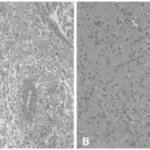Tuberous sclerosis is a rare genetic multisystem disorder with a wide range of potential signs and symptoms and is associated with the formation of benign tumors.
What is the Pathology of Tuberous sclerosis?
Etiology: The cause of Tuberous sclerosis is mutation in one of two different genes, the TSC1 gene or the TSC2 gene.
Genes involved: TSC1 and TSC2.
Pathogenesis: In the cerebrum of patients with tuberous sclerosis (TSC), there are three types of nodular lesions: cortical tubers, subcortical heterotopic nodules and subependymal giant cell astrocytomas.
Histology: The histology associated with Tuberous sclerosis shows hamartomas which contain abnormal giant cells that show evidence of abnormal differentiation of immature neural cells.
How does Tuberous Sclerosis Present?
Patients with Tuberous sclerosis typically are males and females with equal occurrence. The age range is 15-35 years old. The symptoms, features, and clinical findings associated with Tuberous sclerosis include seizures, muscle issues, developmental delays, and rhabdomyomas.
How is Tuberous Sclerosis Diagnosed?
Tuberous sclerosis is diagnosed based with clinical exam in combination with computed tomography (CT) or magnetic resonance imaging (MRI) of the brain. Biopsy may be helpful. —which may show tubers in the brain, and an ultrasound of the heart, liver, and kidneys, which may show tumors in those organs.
How is Tuberous Sclerosis Treated?
Tuberous sclerosis is treated with everolimus.
What is the Prognosis of Tuberous Sclerosis?
The prognosis of Tuberous sclerosis is poor.



